
* The Tupolev OKB got into the jet bomber game with the "Tu-14", a straight-winged machine that had a short and undistinguished service career. The Tupolev organization then went on to develop the more advanced Tu-16, which didn't completely meet specifications but was generally seen as satisfactory, going into service with the Red Air Force and Red Navy. Initially, the "Badger" was focused on the free-fall conventional / nuclear bombing role, but missile-carrier variants were later introduced as well. There was also limited use of the Tu-16 as a somewhat awkward inflight refueling tanker.
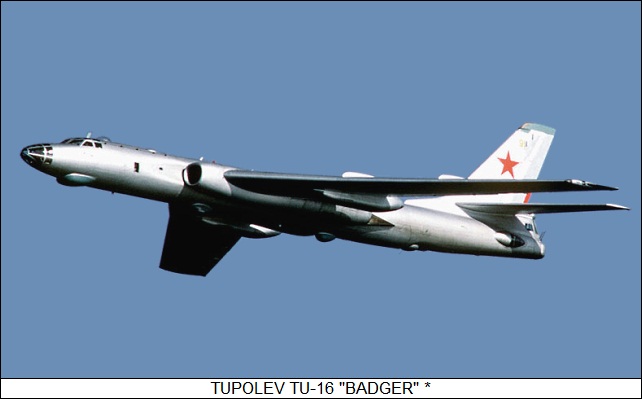
* In the postwar period, Soviet dictator Josef Stalin began high-priority programs to develop modern jet aircraft, using captured advanced German jet aircraft designs to give Red engineers a leg up on the task. One line of investigation was of course for a high-performance jet fighter, with this work culminating in the excellent Mikoyan MiG-15; the other line of investigation was for a jet bomber.
The experimental design bureau (OKB in its Russian acronym) under Andrei Tupolev began development of a jet bomber with the "Tu-12", a jet-powered version of their Tu-2 twin-engine piston-powered bomber. It was really nothing but a practice exercise, and there was never any serious intent to go into production.
The first attempt to develop a production jet bomber focused initially on the "Tu-73", which was a straight-winged aircraft with a swept tailplane, powered by an imported Rolls-Royce Nene turbojet in a nacelle in each wing and a Rolls-Royce Derwent turbojet in the tail, with the intake at the base of the tailfin. It featured a dorsal remote-controlled dorsal barbette with twin Nudelman-Richter NR-23 23-millimeter cannon behind the cockpit, and a similar ventral barbette under the rear fuselage. Initial flight of the Tu-73 was in 1947. A "Tu-78" prototype was also built, being generally similar except for using license-built versions of the Rolls-Royce engines, with RD-45Fs in the wings and an RD-500 in the tail.
Improvements to the RD-45F led to the similar but more powerful "VK-1" turbojet, with 26.5 kN (2,700 kgp / 5,950 lbf) thrust. The VK-1 engines allowed elimination of the clumsy Derwent installation in the tail. Removing the Derwent also meant that a tail turret with twin NR-23s could be fitted. Given good performance, that was seen as adequate defensive armament, and the twin cannon barbettes were eliminated. However, twin fixed forward-firing NR-23s were fitted in the nose. The result was the "Tu-81", which was performed its initial flight in 1949. Prototypes were also flown of "Tu-81R" reconnaissance and "Tu-89" torpedo bomber variants.
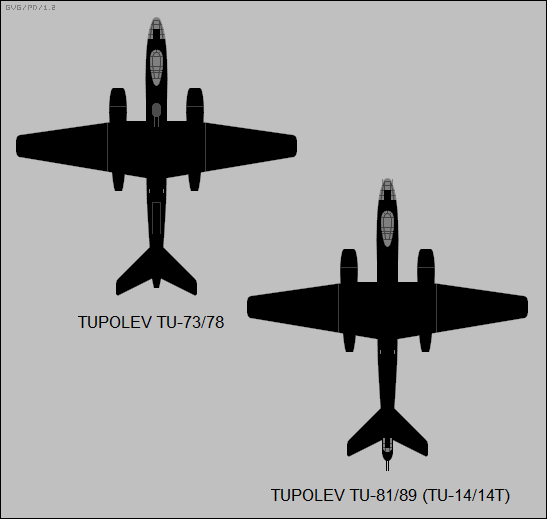
The Tu-89 torpedo bomber was approved for production as the "Tu-14T" for the AVMF, the Soviet naval air arm. It could carry free-fall bombs, mines, and torpedoes. Only about a hundred were built, and it does not appear that any Tu-81 standard bomber or Tu-14R / Tu-81R reconnaissance machines were produced beyond the prototypes. The Tu-14T was thoroughly overshadowed by the conceptually similar but far more successful Ilyushin Il-28 medium bomber. The Tu-14T was assigned the NATO reporting name of "Bosun", no doubt reflecting its naval use, and the type apparently remained in service into the early 1960s.
___________________________________________________________________
TUPOLEV TU-14T BOSUN:
___________________________________________________________________
wingspan:
21.7 meters (71 feet 2 inches)
wing area:
67.36 sq_meters (725 sq_feet)
length:
21.69 meters (71 feet 2 inches)
empty weight:
14,430 kilograms (31,812 pounds)
MTO weight:
25,350 kilograms (55,890 pounds)
max speed at altitude:
845 KPH (525 MPH / 455 KT)
service ceiling:
11,200 meters (36,750 feet)
range:
3,010 kilometers (1,870 MI / 1,625 NMI)
___________________________________________________________________
A swept-wing derivative of the Tu-14, the "Tu-82", sometimes referred to as the "Tu-86", was also flown in 1949, but never entered production. Sources are very unclear on this machine, and it is obscured by a cloud of contrary information. It seems to have been simply a demonstrator for swept-wing technology.
BACK_TO_TOP* The Il-28 did not put the Tupolev OKB out of the jet bomber game. The Soviet Union needed a bigger and more advanced jet bomber beyond the Il-28, and in June 1950 a state requirement was issued to the Ilyushin and Tupolev OKBs for such an aircraft. It was to be a swept-wing machine, powered by Arkhip Lyulka AL-5 turbojets, with high subsonic performance and a range of 8,000 kilometers (5,000 miles), a bomb load of 5,000 kilograms (11,000 pounds), plus armament of seven cannon. An option was provided to use more powerful Arkady Mikulin AM-3 engines, the engine development program permitting.
The Ilyushin OKB wanted to conduct the development program in two steps, beginning with what amounted to a scaled up version of the Il-28 designated the "Il-46", and then building a second prototype with swept wings as the "Il-46S". The Tupolev OKB chose to move directly to the swept-wing design, coming up with an aircraft designated "Tu-88", also referred to as "Type N" as a cover. It featured a pencil-like fuselage; all swept flight surfaces, with mid-mounted wings; twin AM-3 engines, with one in a nacelle on each side of the fuselage; a tail gun installation and remote-controlled barbettes for defensive armament; and tricycle landing gear, with main gear in a pod on the inboard rear of each wing.
The initial (unarmed) prototype Tu-88, now assigned the service designation of "Tu-16", performed its first flight on 27 April 1952, with N.S. Rybko at the controls. The Tu-16 went into state trials in November 1952, with the trials extending into March 1953. The original verdict was a "thumbs down"; Andrei Tupolev himself was disappointed with the performance of the machine. In particular, it was obvious that it wouldn't come close to meeting its range specification.
However, the Tu-16 was still an impressive aircraft, and the problems were not regarded as "show-stoppers": approval for full production of the Tu-16 had already been granted, in December 1952. The trials simply identified issues that needed to be addressed, and the second Tu-16 prototype, which performed its first flight on 6 April 1953 with Rybko at the controls, incorporated such improvements as a lighter airframe, increased fuel capacity, and longer nose. The second prototype was also closer to production spec, with defensive armament and offensive radar system. The second prototype successfully completed trials a year later, in April 1954, with a recommendation for service acceptance issued in May 1954.
The Ilyushin Il-46 program had been halted in the summer of 1953, and the swept-wing Il-46S prototype was never built. The Ilyushin OKB did develop two swept-wing twin-engine bombers, the "Il-30" and the "Il-54", but neither entered service and their histories are obscure. At the same time the Il-46 program got the axe, work towards manufacture of the Tu-16 was begun at State Factory 22 in Kazan. The first production Tu-16 was rolled out at the Kazan factory on 29 October 1953.
A total of nine Tu-16s performed a flypast at the May Day parade in Moscow on 1 May 1954, and 40 performed a flypast at the Tsushino Air Show in August. NATO assigned the type the reporting name "Badger"; these early machines would acquire the modified label of "Badger-A" once later versions appeared.
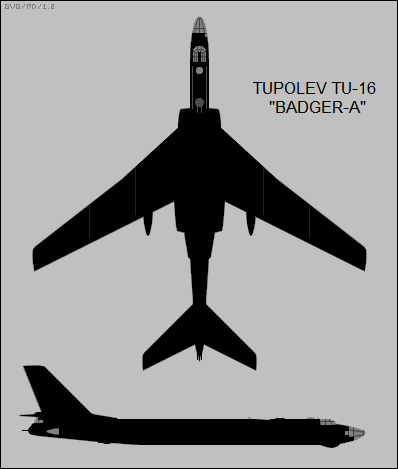
The Kazan plant built the majority of Tu-16s. Acquisition of the Tu-16 was a high priority for the USSR, and so Kazan production was soon supplemented by manufacture of aircraft at State Factory 1 in Kuibyshev (now Samara). A number were also built at State Factory 64 in Voronezh from 1955. The last new-build Tu-16s were rolled out in 1963.
Tu-16s were produced in large quantity and served in a wide range of roles, flying as bombers, missile carriers, torpedo bombers, antisubmarine warfare (ASW) platforms, reconnaissance and maritime surveillance platforms, electronic countermeasures (ECM) platforms, inflight refueling tankers, search and rescue (SAR) platforms, and trials / experimental platforms. Many were heavily modified during their lives to take on new roles for which they had not originally been built. They generally flew in natural metal finish, though AVMF machines often sported natty maritime colors of dark gray on top and light gray underneath.
BACK_TO_TOP* The initial production Tu-16 provides a baseline for description of the family. The Tu-16 was an all-metal aircraft, built mostly of aircraft aluminum. The Tupolev OKB had built the Tu-4, the Soviet copy of the US Boeing B-29 Superfortress, and the Tu-16's long, slender fuselage clearly reflected influence from that source. While the prototypes and early production Tu-16s were powered by twin AM-3 engines with 66.2 kN (6,750 kgp / 14,880 lbf) thrust each, main Tu-16 production was powered by the considerably uprated AM-3M engine -- known in production as the RD-3M, where the "RD" suffix stood for "Reactivniy Dvigatel", more or less translating to "reaction device / jet engine" -- with 93.2 kN (9,500 kgp / 20,950 lbf) thrust.
The two-spar wings were mid-mounted on the engine nacelles and had a sweep of 41 degrees on the inboard third of the wing, and 35 degrees sweep on the outboard wing. The wings had 1 degree of incidence and 3 degrees of anhedral droop. There were big single-piece flaps and ailerons with trim tabs on the rear of the wings, as well as twin fences on top of each wing; the prototypes and early production had shorter fences than main production machines. The tail assembly was of conventional configuration, with all swept flight surfaces. The wing used an engine-air bleed de-icing system, while the tail surfaces were electrically de-iced.
___________________________________________________________________
TUPOLEV TU-16 BADGER-A:
___________________________________________________________________
wingspan:
32.93 meters (108 feet)
wing area:
164.65 sq_meters (1,772.34 sq_feet)
length:
36.25 meters (118 feet 11 inches)
height:
14 meters (45 feet 11 inches)
empty weight:
37,200 kilograms (82,000 pounds)
MTO weight:
75,800 kilograms (167,100 pounds)
max speed at altitude:
990 KPH (615 MPH / 535 KT)
service ceiling:
15,000 meters (49,200 feet)
range:
5,925 kilometers (3,680 MI / 3,200 NMI)
___________________________________________________________________
The nose gear was steerable, had twin wheels, and retracted backward. The main gear, with a 2x2=4 configuration, retracted backwards in their wing pods and flipped over to stow, an exercise that must have been interesting to watch. Apparently the Tu-16 was the first production Soviet aircraft with the 2x2=4 main gear arrangement. There was also a small retractable bumper wheel under the rear fuselage to prevent scrapes on high-angle take-offs. All wheel assemblies were hydraulically actuated. A brake chute could be used to reduce landing roll.
The weapons bay had large volume to allow it to carry a nuclear weapon. It could also carry a FAB-9000 9,000-kilogram (19,850-pound) conventional bomb, though more usually in the conventional bombing role it carried a number of smaller munitions. Typical bomb loads were up to 16 FAB-250 (550-pound) or 12 FAB-500 (1,100-pound) bombs; in the late 1960s, many Badger-As were modified to increase the maximum bombload to 24 FAB-250 or 18 FAB-500 bombs. The twin weapons bay doors were electrically actuated. A radar altimeter was fitted just forward of the weapons bay. There were large fuel tanks fore and aft of the weapons bay, and the wings were full of fuel tanks. A stores pylon could be attached under each wing, though this would not be used for free-fall bombing, instead being employed on the missile carriers and reconnaissance variants described below.
The Tu-16's seven guns were all NR-23 23-millimeter cannon, with one fixed to fire forward in the nose -- presumably the pilot had a gunsight to help with aiming -- and the others mounted in three twin-cannon turrets, including a remote-controlled forward dorsal barbette, a similar barbette in the rear ventral position, and a manned tail turret. The tail gunner could use a gun aiming radar, mounted in a fairing at the base of the tailfin. The NATO reporting name for this radar was, of course, "Bee Hind"; the same radar was used on other large Soviet aircraft.
The fixed nose gun seems like an odd feature -- the Tu-16 was on the big side to be making strafing attacks, much less dogfighting -- and it would often be deleted in other Tu-16 variants. Later in life, Tu-16s were retrofitted with the SPS-100 Rezeda countermeasures jammer, which was a bulky item that replaced the tail turret with a prominent, bulbous tail extension.
There were six crew, including a bombardier / radar navigator, pilot, copilot, and navigator / gunner in the forward section of the fuselage; plus radio operator / gunner and tail gunner in the rear fuselage. All crew spaces were pressurized. The bombardier / radar navigator sat behind a glazed nose, using an optical bombsight peering through a flat panel under the nose as well as PRS-1AG Argon navigation / bombing radar, mounted in a radome under the cockpit. The bombardier / navigator got into the aircraft through a hatch with a pull-out ladder just under the nose.
The pilot and copilot sat side-by-side on armored, upward-firing ejection seats; the rest of the forward-section crew used downward-firing ejection seats. The navigator / gunner sat behind the cockpit in an avionics bay, using a prominent bubble dome to take navigation shots or control the forward cannon barbette. The dome and dorsal barbette were flanked by long distinctive "towel rack" antennas for HF communications. All three of the forward crew got into the aircraft through a belly hatch in front of the nose gear.
The radio operator / gunner sat in a compartment underneath the tailfin, with a blister on each side of the fuselage underneath the tailplane for observation and aiming the rear cannon barbette. The tail gunner of course sat in the extreme tail; the two crew got inside the aircraft through tandem belly hatches. The tail section crew did not have ejection seats, instead bailing out through the hatches, which opened to serve as windbreaks.
* A total of 294 standard Tu-16 Badger-A bombers was built, with the deliveries split between Long Range Aviation (DA) and the AVMF. At least some were configured to carry the radio-guided 2,240-kilogram (4,940-pound) UB-2F Tchaika radio-guided glide bomb -- one carried under each wing -- or larger 5,100-kilogram (11,250-pound) UB-5 Kondor radio-guided glide bomb, with one carried on the centerline. These were primitive weapons, with the bombardier tracking the bomb visually using flares in the tail of a bomb and adjusting its path with a hand controller over a radio datalink. The main problem with them was that the aircraft had to maintain a line of sight to the target until a bomb went home, meaning the aircraft was vulnerable during that interval. The Tchaika and Kondor had short service lives.
A separate variant, the "Tu-16A", was built for nuclear strike, with a total of 394 produced. The Tu-16A featured a heated weapons bay to keep the bomb's sensitive electronics working; pull-down blinds for the crew cockpit; and a special belly finish to tolerate nuclear flash. 59 more of the nuclear bomber variants were built with facilities for inflight refueling and designated "Tu-16ZA". NATO observers couldn't spot much difference with these variants, and so they were labeled "Badger-A" machines.
* Red Air Force Tu-16As -- and Tu-16KSR-2-5s, this variant being essentially a Tu-16A that could carry anti-shipping missiles and described below -- actually saw a fair amount of combat late in their service lives, performing carpet-bombing raids against Mujahedin insurgents during the Afghanistan conflict of the 1980s. They flew in formations of three or four aircraft, or sometimes eight to ten aircraft; in 1984 one raid featured 24 aircraft, each carrying 24 to 40 FAB-250 250-kilogram (550-pound) general-purpose bombs.
BACK_TO_TOP* The Tu-16 proved to be a very reliable and rugged machine, if apparently demanding to fly. It would be the mainstay of the Soviet nuclear deterrent in the late 1950s and early 1960s, though its inadequate range was a troublesome limitation. Once intercontinental ballistic missiles (ICBMs) came online in the early 1960s, the Tu-16 was gradually shifted to other roles.
The only way to address the range issue was to provide inflight refueling, Directives were issued in 1953 to implement such a system, with the first "Tu-16Z" tanker conversion tested in 1955. The scheme went into service in 1958. The Tu-16AZ nuclear bombers, mentioned above, were built with the refueling gear, and apparently most or all of the Tu-16 and Tu-16A bombers were retrofitted with it.
The Soviets seem to have had a considerable amount of trouble developing an inflight refueling capability. The Tu-16Z tanker system was clumsy on the face of it: a hose was strung off the right wingtip of the tanker, to hook up with a receiver system on the left wingtip of a receiver aircraft. The right landing gear pod of the tanker had a searchlight system for night refuelings. There were 114 Tu-16Z conversions, including some from Tu-16AZ bombers that were confusingly designated "Tu-16ZA". The Tu-16Z/16ZA tankers were recognizable by tablike wingtip extensions.
The refueling procedure was tricky and apparently resulted every now and then in accidents, some of them disastrous. A "Tu-16N" with a conventional hose-drogue unit installed in the bomb bay along with the wingtip refueling gear was introduced in 1963, with a number of machines produced by conversion. This led to a further improved version, the "Tu-16NN", which was similar to the Tu-16N but lacked the wingtip refueling system and had wingtip endplate fins to improve station-keeping. 20 conversions were performed. A single "Tu-16D" equipped as a receiver for conventional hose-drogue refueling was produced by conversion, but though the evaluation of the machine was successful, the configuration was not adopted for service. Eventually, Badger mid-air refueling was de-emphasized.
* The Red Navy AVMF was a Badger user from the start, and early on a torpedo-bomber variant, the "Tu-16T", was developed for that service branch, with 76 built in all. It looked pretty much like a standard Tu-16 bomber and could drop ordinary free-fall bombs, but it could carry up to ten torpedoes or up to twelve mines in the weapons bay.
The anti-ship torpedo bomber was an obsolete concept even at the time, and the mission for which the Tu-16T had been specifically designed quickly ceased to exist. In fact, it was the last torpedo bomber in Soviet service. In 1962, a number of Tu-16Ts were modified as "interim" antisubmarine warfare (ASW) platforms by fitting them with the Baku sonobuoy receiver system and allowing them to carry 40 sonobuoys and depth bombs in the weapons bay. These machines were redesignated "Tu-16PL"; ironically, they were later further updated to carry antisubmarine homing torpedoes, turning them back into torpedo bombers of a sort. The Tu-16PLs were retired in the late 1960s when better airborne ASW assets became available.
BACK_TO_TOP* The Badger's service as a free-fall bomber was thoroughly overshadowed by its labors as a missile carrier. The evolution of the Tu-16 in this role is elaborate and confusing. The USSR had begun work on heavy anti-shipping cruise missiles in the late 1940s, with the early "Kometa" system introduced in the mid-1950s. It was based on the Mikoyan "KS-1" missile, known to NATO as the "AS-1 Kennel", which was something like a baby MiG-15 fighter with no cockpit, a radome for an anti-shipping radar seeker in the nose, and a fairing for a radio control link on top of the tail. The missile could also be used against prominent land targets, such as bridges.
Carriage on the obsolescent Tu-4 B-29 clone was judged unsatisfactory, and so in 1954 a Tu-16 was modified as a KS-1 carrier. One missile was carried on each underwing rack for a total of two, with the fuel supply of the missiles topped up from the carrier's fuel tanks. A missile operator was added to the crew, with the new crewman working from a capsule loaded into the weapons bay. Apparently the capsule was uncomfortable, particularly in warm weather.
Although a midcourse guidance control datalink system was added to the bomber, the radar system was not upgraded, since the range of the original KS-1 was only about 80 kilometers (50 miles), and the Argon radar could spot large naval vessels at that range. An extendable drum antenna fairing was fitted behind the weapons bay to accommodate the datalink. The "Tu-16KS", as the missile carrier variant was designated, went into service with the AVMF in 1955, with a total of 107 built. It was given the NATO reporting name of "Badger-B".
An improved KS-1 was introduced in the late 1950s, featuring folding wings and range stretched to 150 kilometers (95 miles), but the KS-1 was never all that satisfactory a weapon. Even 150 kilometers was not a very safe standoff distance from a Western naval group with air defenses; the KS-1 was strictly subsonic, making it vulnerable to defenses as well; and the Tu-16KS had to perform midcourse guidance for the missile until the missile's anti-ship radar seeker was within range, the carrier aircraft remaining vulnerable in the meantime.
* By the late 1950s, the USSR was testing what amounted to a rocket-propelled derivative of the KS-1 with improved aerodynamics. The new missile, the "KSR-2" (NATO AS-5 Kelt), had a range of 170 kilometers (105 miles) and marginally supersonic performance. The guidance scheme was conceptually the same as for the KS-1. An enhanced carrier aircraft configuration was required for the new missile, the result being the "Tu-16KSR-2", or sometimes "Tu-16K-16", with an improved Rubin-1k (Rn-1k) radar (NATO "Short Horn"), an improved autopilot, flaps with a 5 degree lower pivot, and cutouts in the flaps to allow them to clear the missile tailfin. It is unclear if the original Tu-16KS missile carriers had the cutouts as well.
From 1962, a total of 205 machines was converted to the Tu-16KSR-2 configuration. Older Tu-16KS aircraft updated were known simply as Tu-16KSR-2, while free-fall bombers updated to the configuration were designated "Tu-16KSR-2A". In any case, the variant received the NATO reporting name of "Badger-G". It retained the ability to drop free-fall munitions as a secondary mission. Some were upgraded in the 1970s with SPS-5 Fasol and SPS-100 Rezeda defensive jammers, with the SPS-100 replacing the tail turret.
A radar-homing version of the KSR-2 was also developed and given the designation of "KSR-11". That led to the upgrade of aircraft featuring a Ritsa targeting system, identified by a small antenna mounted on top of the very tip of the nose. Fit of the Ritsa required removal of the fixed nose cannon. The improved machines were designated "Tu-16KSR-2-11" or alternatively "Tu-16K-11-16", or "Tu-16K-11-16KS". It appears there were very slight differences between aircraft with the different designations -- the designations indicating the type of aircraft that had been upgraded. NATO still referred to them as "Badger-Gs". Long Range Aviation operated 211 such aircraft, while the AVMF operated 130.
* The KS-1 and KSR-2/11 missiles were relatively crude; the Soviets were determined to come up with much better weapons, and accordingly introduced the "KSR-5" (NATO AS-6 Kingfish) in the late 1960s. This was an anti-ship missile in the shape of a big dart with delta wings, using rocket propulsion powered by storable fuels. The KSR-5 had extended range, was capable of Mach 3, and featured a sophisticated guidance system.
Of course, Tu-16s were upgraded to carry the new missile, with the upgraded aircraft given the designations "Tu-16KSR-2-5-11", "Tu-26K-26" (the entire missile system was designated "K-26"), or "Tu-16KSR-2-5". Again, there were slight differences between conversions with different designations; the Tu-16KSR-2-5-11 (and the Tu-26K-26) could carry the KSR-11 anti-radar missile, while the Tu-16KSR-2-5 lacked the Ritsa targeting system and could not carry the KSR-11. There were 250 conversions in all. NATO assigned the subvariant the reporting name of "Badger-G Mod".
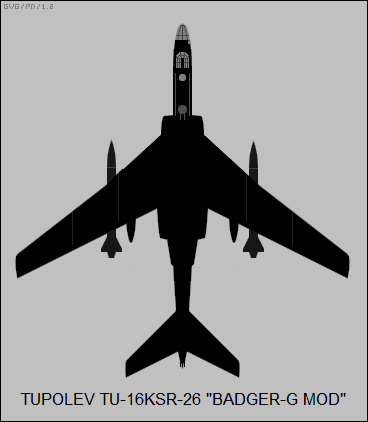
In practice, only one missile was usually carried, not two. The KSR-5's range was actually greater than that of the Rubin-1k radar, and so a good number of these machines were eventually fitted with the further improved Rubin-1m radar. An anti-radar version of the KSR-5 designated the "KSR-5P" was later introduced, and a number of aircraft were upgraded, once more, to carry it; these machines were designated "Tu-16K-26P".
* While work proceeded on this series of upgrades, the Soviets also pursued a separate line of missile carriers based on the Badger. In the 1950s, work was begun on a heavy anti-ship / land attack missile, which emerged as the "K-10S". It was powered by an afterburning turbojet slung under the fuselage and went into service in 1960. NATO assigned it the reporting name "AS-2 Kipper".
Although the Badger missile carriers discussed so far were straightforward modifications of free-fall bomber variants, the machines designed to carry the K-10S featured significant changes. Only one missile was carried, fitted into a belly recess and extended on a pylon for launch. This of course eliminated the capability to perform free-fall bombing as a secondary mission. Even more noticeably, the nose glazing was replaced by a "fat" nose radome for a YeN (NATO "Puff Ball") wide-angle, long-range search and targeting radar. The radome surprisingly improved the aircraft's aerodynamics. The original radome under the cockpit was retained, but it contained the control link antenna for the missile, not a radar. A missile systems operator was added to the crew and housed in a pressurized cabin in the weapons bay.
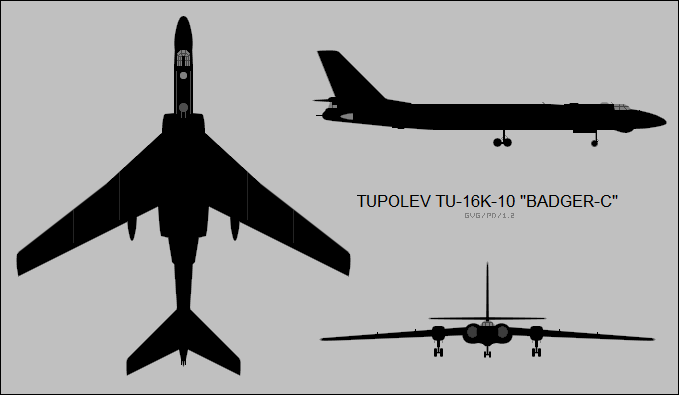
The revised aircraft were designated "Tu-16K-10". The changes required were so significant that no serious thought was given to modifying existing Badgers, and so all Tu-16K-10s were new-build machines, with a total of 216 built. NATO assigned the variant the reporting name of "Badger-C". As with the other family of missile carriers, the Tu-16K-10s were successively upgraded to handle improved weapons, such as the low-level K-10SN variant; the K-10SD/SND extended-range variant; and the K-10SP jamming variant, which was to be launched as part of a salvo to help other missiles penetrate target defenses.
In the mid-1960s, the Soviets took the logical step of initiating an upgrade of the Tu-16K-10 that could not only carry a K-10S-series missile under the centerline, but also carry a KSR-2 or KSR-5 missile under each wing. The conversion involved adding the wing stores racks, strengthening the wings, and adding notched-out flaps with steeper maximum flap settings. The subvariant was designated, logically, the "Tu-16K-10-26" and introduced into service in 1969. 85 conversions from other Tu-16K-10 subvariants were performed; NATO gave the Tu-16K-10-26 the reporting name of "Badger-C Mod".
In the mid-1970s, some of the Tu-16K-10-26 aircraft were fitted with the avionics for carrying the KSR-11 and KSR-5P radar-homing missiles. These aircraft were designated "Tu-16K-10-26P". Improved "Taifun" avionics were installed in these machines in the late 1970s and early 1980s.
* One particularly bizarre variation on the Tu-16K-10 series was the "Tu-16K-10-26B" conversion performed on a number of aircraft by the AVMF in the early 1970s. They were essentially Tu-16K-10-series machines fitted with 12 external bomb racks, with each rack able to carry up to a 500-kilogram (1,100-pound) munition for a total warload of 9,000 kilograms (19,850 pounds). An OPB-1RU optical bombsight was fitted; it is unclear if any nose glazing was added to give the bombardier any view of the target. Nobody is exactly sure what the Red Navy was thinking when they ordered this contraption; it may have been an aerial minelayer.
The only time any of the missile carriers operating in Soviet service actually launched on a live target was in 1964, when test firings were being performed in the North Pacific and a Japanese timber freighter, the SINE-MARU, strayed into the range area. A K-10SND missile locked on to the freighter, but fortunately as a safety measure the missile was configured to blow up a few hundred meters short of the target. A Japanese crewman was injured by shrapnel and likely other members of the crew got a case of the jitters, but there was no other harm done. An investigation followed. However, the missile carriers would perform some combat launches in export service, as discussed later.
BACK_TO_TOP